The following section contains a series of pie charts and statistics compiled of the artifacts in the CCT assemblage by type of materials and wares. The treemaps show the proportion of the different types of artifacts in the CCT assemblage. The project team was able to compile a full database on the 14th-century-1600 porcelain sub-assemblage and 14th-century-1600 stoneware sub- assemblage, and a large sampling of the earthenware and colonial artifacts. The statistics presented here characterize a full sample of the entire CCT assemblage, excluding the construction debris (which were collected, but we will not be including them in the study and database). The data entry of all remaining earthenware and colonial artifacts will continue and future updates will be provided as and when they are ready. The goal of the project is to produce a database of 3,000 artifacts; and whilst the research and cataloguing will continue following the uploading of this report and database; updates will be uploaded periodically to the database. Further sections may also be added and these comprise specific detailed studies on individual types of ware.
| Period | Type of Material | Number of Sherds/Pieces |
|---|---|---|
| 14th-15th C Ceramics | Porcelain | 538 |
| 14th-15th C Ceramics | Stoneware | 1547 |
| 14th-15th C Ceramics | Earthenware | 2538 |
| 19th-20th C Ceramics | Porcelain | 708 |
| 19th-20th C Ceramics | Stoneware | 596 |
| 19th-20th C Ceramics | Earthenware | 140 |
| 19th-20th C Artifacts | Metal | 283 |
| 19th-20th C Artifacts | Organic Material | 213 |
| 19th-20th C Artifacts | Stone | 21 |
| 19th-20th C Artifacts | Glass | 128 |


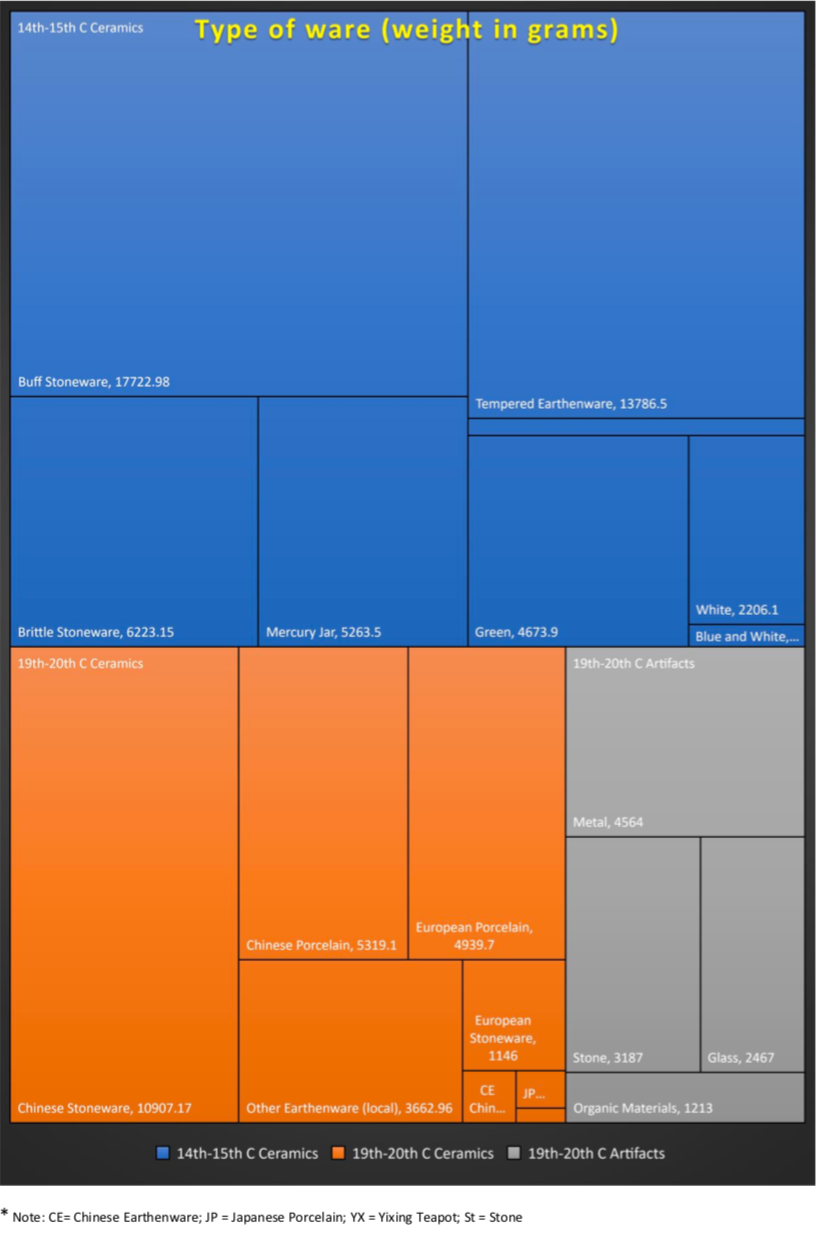
CCT Porcelain
Percentage of green porcelain, white porcelain, and blue and white porcelain in the CCT porcelain sub-assemblage:
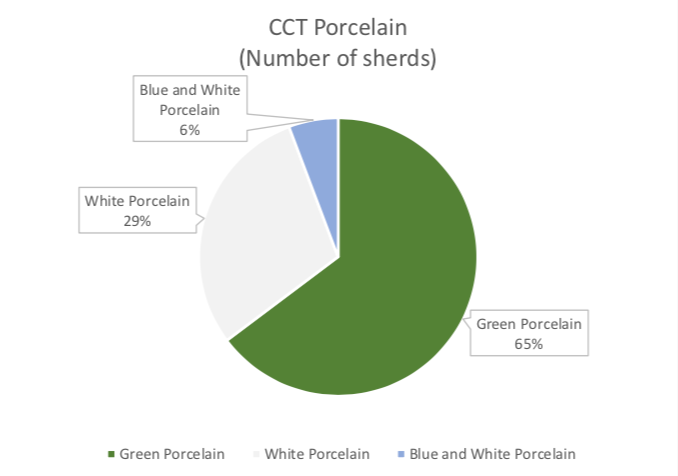
Number of sherds by type of porcelain:
- Green Porcelain: 349 sherds
- White Porcelain: 159 sherds
- Blue and White: 30 sherds
- Total number of sherds: 538
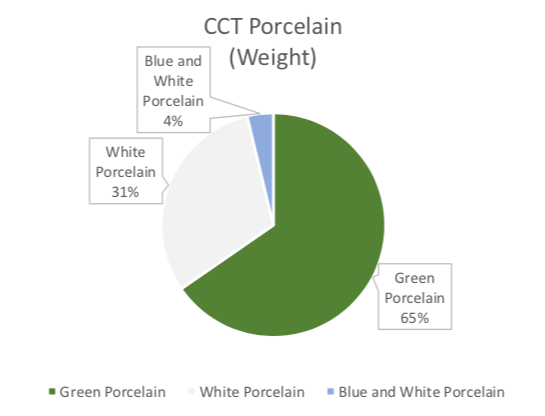
Weight by type of porcelain (in grams):
- Green porcelain: 4,673.9g
- White porcelain: 2,206.1g
- Blue and white porcelain: 260g
- Total weight: 7,140g
*Note: the proportion of porcelain is representative of the greater quantities of green porcelain as opposed to white porcelain and blue and white. The relative proportions of these wares are quite consistent of the distribution of green, blue and white, and white porcelain in Singapore archaeological sites.
Percentage of features versus body sherds (by type of porcelain):
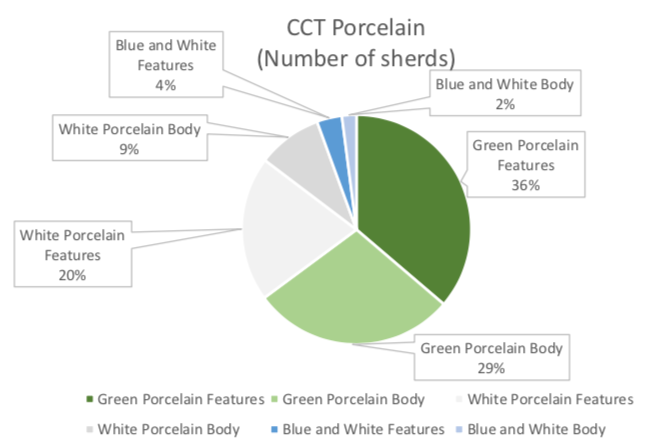
Percentage of features versus body sherds (by weight):
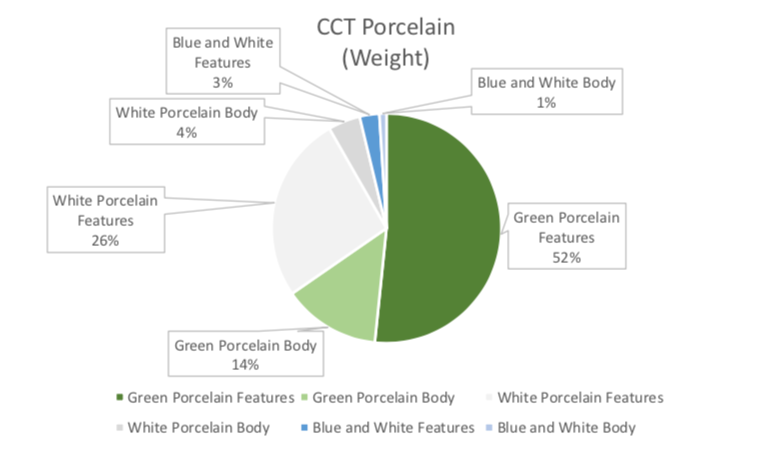
CCT Stoneware
Percentage of mercury jar, brittle stoneware and buff stoneware in the CCT stoneware sub-assemblage:
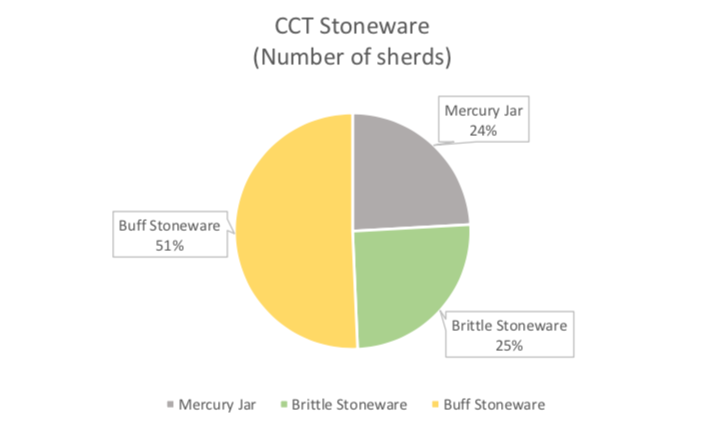
Number of sherds by type of stoneware:
- Mercury Jar: 373 sherds
- Brittle Stoneware: 390 sherds
- Buff Stoneware: 784 sherds
- Total number of stoneware sherds: 1,547
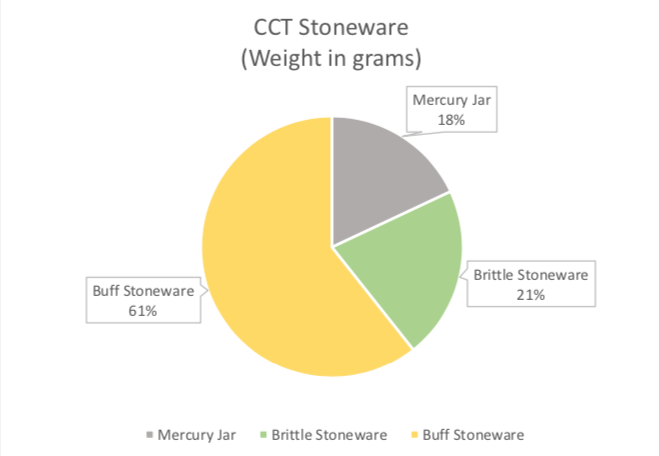
Weight by type of stoneware:
- Mercury Jar: 5,263.5g
- Brittle Stoneware: 6,223.15g
- Buff Stoneware: 17,722.98g
- Total weight for all three wares: 29.209kg
Points to note:
Buff Stoneware is the most representative in both number of pieces and weight, followed by Brittle Stoneware and then Mercury Jar. There are more Buff Stoneware in pieces and weight because they usually comprise large jars which can be broken into more pieces, but also weigh more. Hence it would be important to be able to determine the minimum number of vessel count which provides a more accurate approximation of the actual number of vessels found at the site.
In terms of number of sherds, the proportion of Brittle Ware and Mercury Jar is almost comparable (25% to 24%), but in terms of weight, Brittle Ware weighs more as there is typically a range of vessel sizes from large jars to medium sized jars and jarlets whereas mercury jars largely conform to a standardized size with few exceptions.
As Buff stoneware contains no temper and usually thicker body and fired at a lower temperature relative to Mercury Jar and Brittle stoneware, they weigh more.
Percentage of features versus body sherds (by type of stoneware):
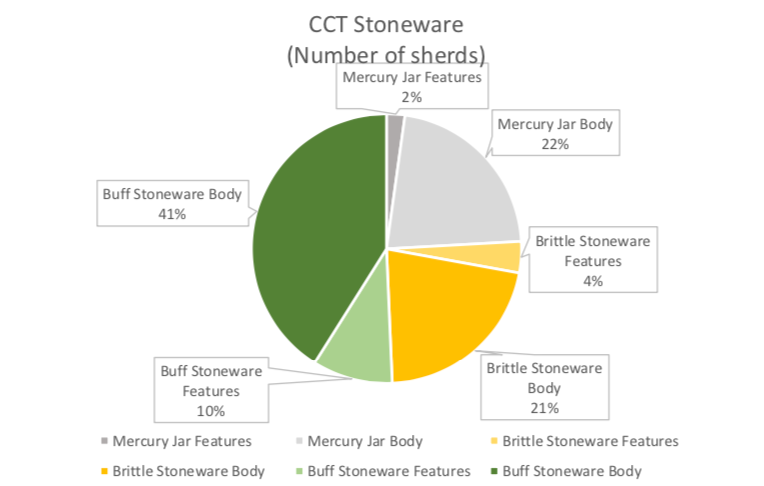
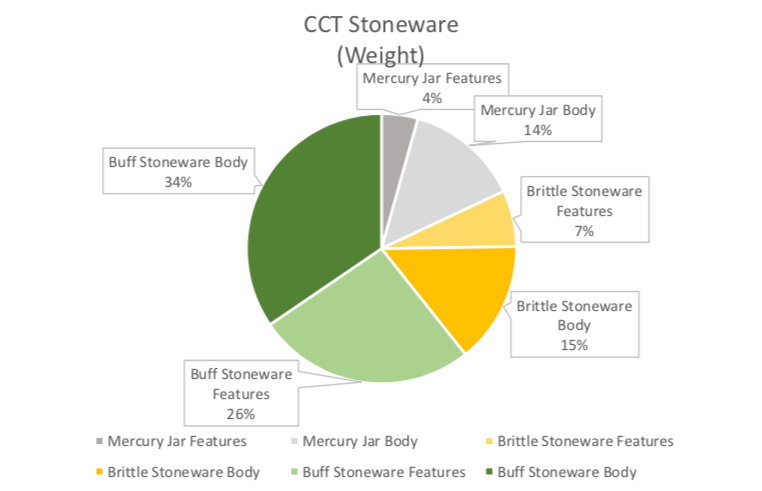
CCT Earthenware
Percentage of fine paste earthenware and tempered earthenware in the CCT earthenware sub-assemblage*:
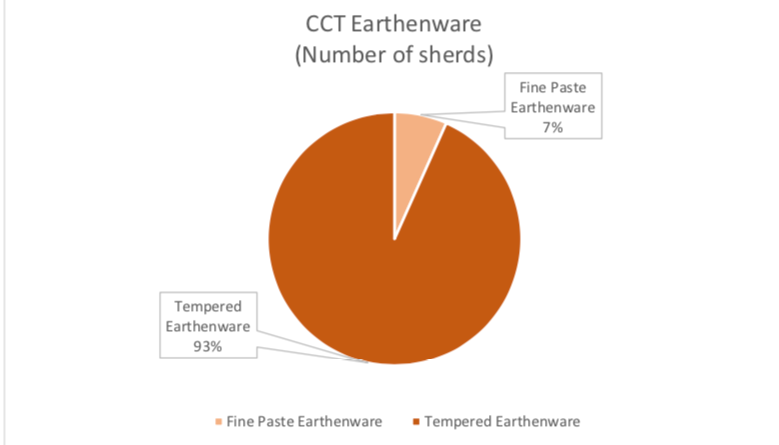
Number of sherds by type of earthenware:
- Fine Paste Earthenware: 170 sherds
- Tempered Earthenware: 2368 sherds
- Total number of sherds: 2538

Weight by type of earthenware:
- Fine Paste Earthenware: 579.6g
- Tempered Earthenware: 13,786.5g
- Total weight in grams: 14,366.1
Percentage of features versus body sherds (by type of earthenware):

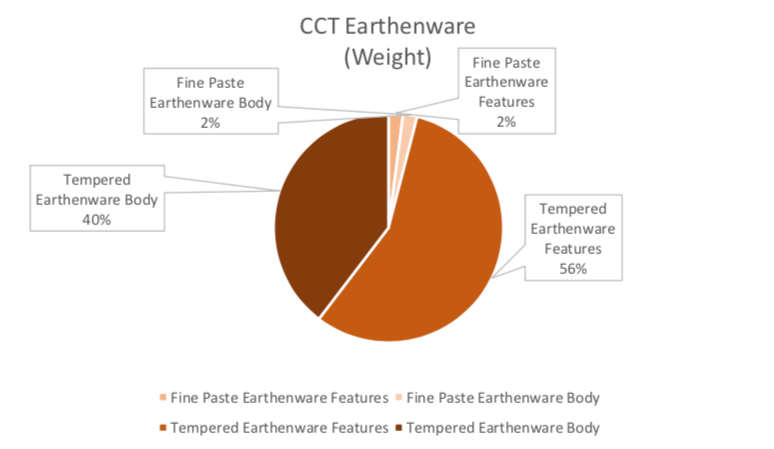
Points to note:
Fine Paste Earthenware has no temper and is fired at a lower temperature, usually in a kiln or under kiln-like conditions. The Fine Paste Earthenware in the CCT sub-assemblage can be divided into two main types: Pa O type of ware, some of which have decorations such as punctated circles with a dot in the middle; and burnished slipped earthenware, a few of which are necks from East Java.
In terms of number of sherds, fine paste earthenware is very fragile and tends to break into many pieces, which will explain why the proportion of percentage is higher than when comparing the weights of fine paste earthenware and tempered earthenware.
Tempered earthenware comprises a range of vessel types, forms, sizes, and decoration (techniques and motifs). This category of tempered earthenware can also be further classified in sub-categories according to the temper used (types of temper used), the size of the temper (grain size for instance), and the density of temper (distance measured between different temper grains) etc. A detailed study of this will be undertaken by the PI’s graduate student and will be made available when ready.
*The statistics presented here comprise the complete sample of fine paste and tempered earthenware. However the fine paste earthenware and tempered earthenware entered into the database represent a proportion of the entire CCT earthenware sub-assemblage. The team will continue with the analysis and will prepare a complete report on all artifacts at a later stage.
CCT Colonial Artifacts
The colonial artifacts are still being sorted, analyzed, and catalogued; the data presented here represent a sampling of the artifacts found in the assemblage. A complete database will be provided at a later stage when all artifacts have been classified and information entered.
*Percentage of porcelain (Chinese, European and Japanese), stoneware (Chinese and European), earthenware (Chinese and local), organics (shells, corals, charcoal), metal , stone, and glass in the colonial artifacts sub-assemblage:
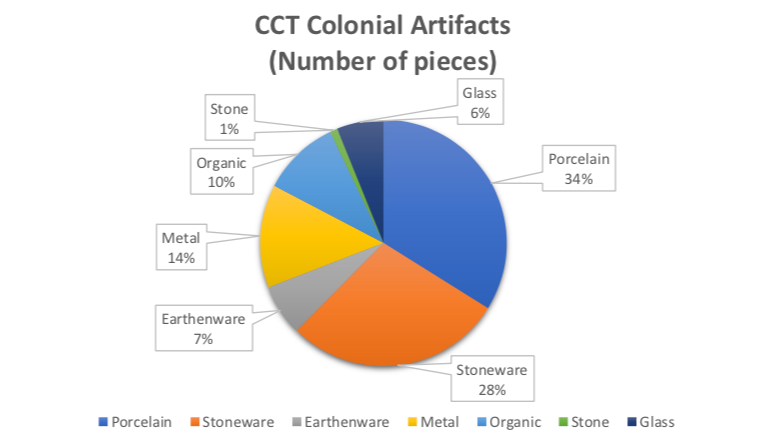
Number of sherds/pieces by type of artifacts:
- Porcelain: 708 sherds
- Stoneware: 596 sherds
- Earthenware: 140 sherds
- Metal: 283 pieces
- Organic material: 213 pieces
- Stone: 21 pieces
- Glass: 128 shards
- Total number of items: 2,089

Weight by types of artifact:
- Porcelain: 10,444.8g
- Stoneware: 12,053.17g
- Earthenware: 3,835.76g
- Metal: 4,564g
- Organic material: 1,213g
- Stone: 3,187g
- Glass: 2,467g
- Total weight in grams: 37764.73
*A sampling of the different categories of artifacts (ceramics and non-ceramics) which were recovered from the colonial sub-assemblage of artifacts.
Breakdown of the Colonial Ceramics by Type of Material
This section presents the breakdown in terms of number of sherds and weight of the various ceramic categories in the CCT colonial artifacts sub-assemblage:
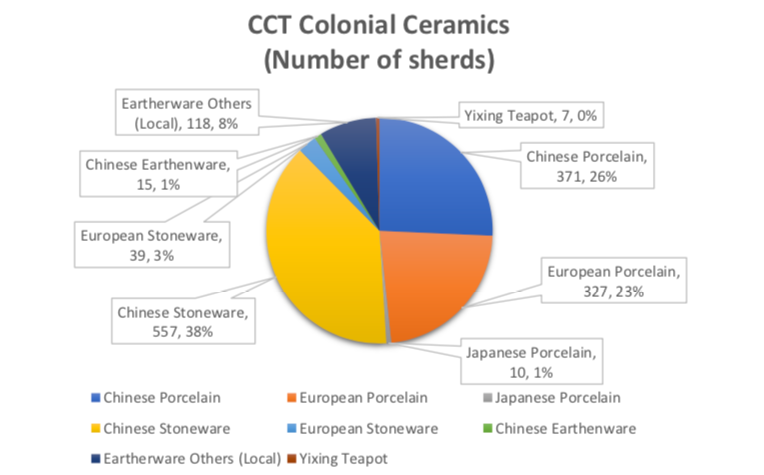
Number of sherds by type of ware:
- Chinese porcelain: 371 sherds
- European porcelain: 328 sherds
- Japanese porcelain: 10 sherds
- Chinese stoneware: 557 sherds
- European stoneware: 39 sherds
- Chinese earthenware: 15 sherds
- Other earthenware (local): 118 sherds
- Yixing Teapot: 7 sherds
- Total number of sherds: 1,444
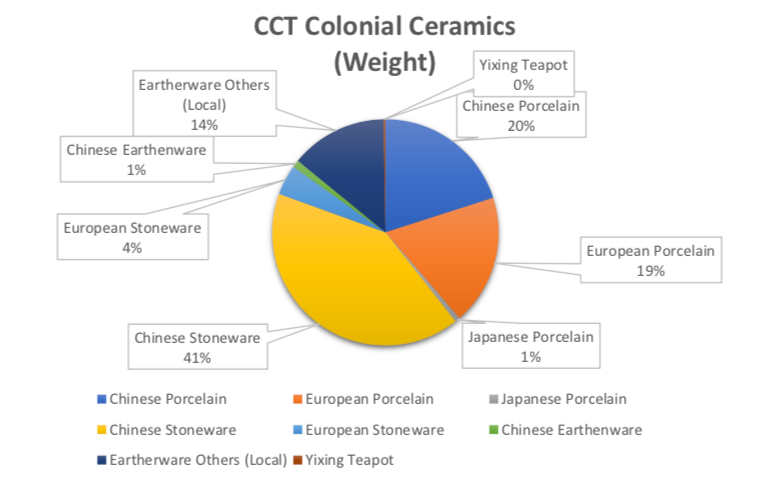
Weight by types of ware:
- Chinese porcelain: 5,319.1g
- European porcelain: 4,939.7g
- Japanese porcelain: 186g
- Chinese stoneware: 10,907.17g
- European stoneware: 1,146g
- Chinese earthenware: 279.8g
- Other earthenware (Local): 3,662.96g
- Yixing teapot: 73g
- Total weight in grams: 26510.73